Surfactants Market Size 2024-2028
The surfactants market size is forecast to increase by USD 13.2 billion, at a CAGR of 5.23% between 2023 and 2028.
Major Market Trends & Insights
- APAC dominated the market and accounted for a 43% growth during the forecast period.
- By the Product - Anionic segment was valued at USD 15.40 billion in 2022
- By the Application - Detergents segment accounted for the largest market revenue share in 2022
Market Size & Forecast
- Market Opportunities: USD 51.29 billion
- Market Future Opportunities: USD 13.20 billion
- CAGR : 5.23%
- APAC: Largest market in 2022
Market Summary
- The market is a dynamic and expansive industry, characterized by continuous innovation and growth. According to recent studies, the global market for surfactants is projected to reach a significant index number by 2026, representing a notable increase from its current size. This expansion is driven by the increasing demand for various consumer goods, particularly in the sectors of personal care, household cleaning, and industrial applications. In the personal care industry, the adoption of surfactants has seen a substantial rise due to their ability to enhance the foaming, cleansing, and emulsifying properties of personal care products. In the household cleaning sector, surfactants are essential for the production of detergents, which are used extensively in various applications such as laundry, dish washing, and floor cleaning.
- Moreover, the industrial sector utilizes surfactants in various applications, including oil recovery, mining, and textile processing. Despite the market's positive growth, there are challenges that persist, such as the volatility in raw material prices and the need for stringent regulations. However, the ongoing R&D activities in the industry are aimed at addressing these challenges and driving innovation, ensuring the market's continued growth and evolution.
What will be the Size of the Surfactants Market during the forecast period?
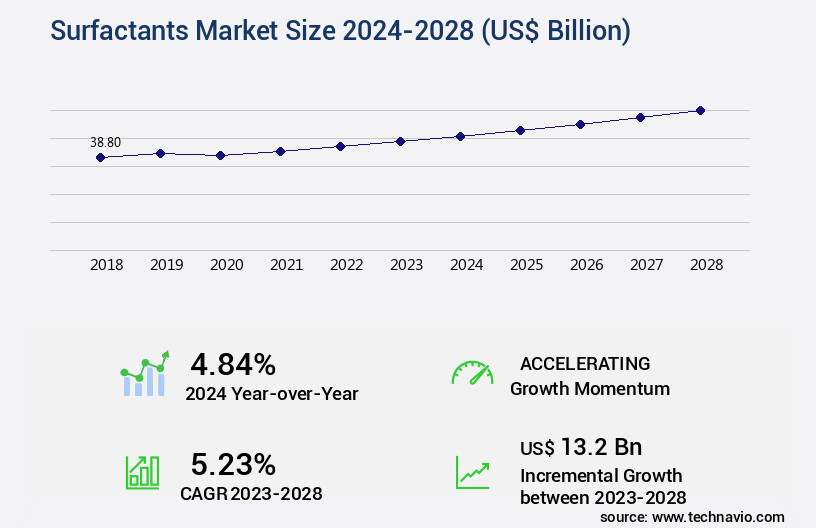
Explore market size, adoption trends, and growth potential for surfactants market Request Free Sample
- The market encompasses a diverse range of chemicals that modify the interfacial properties between oil and water. These compounds, characterized by their HLB (hydrophilic-lipophilic balance) values and contact angles, play a crucial role in various industrial applications, including phase behavior, formulation optimization, and performance enhancement. The market is projected to reach a significant value by 2025, growing at a steady rate due to increasing demand for detergents, personal care products, and agrochemicals. For instance, the solubility parameter of surfactants in these industries facilitates effective emulsion stability and foam stability, contributing to their widespread use.
- Interfacial tension, a key property of surfactants, is a critical factor in determining their efficiency at reducing surface tension between oil and water. For example, anionic surfactants typically exhibit lower interfacial tension values compared to nonionic surfactants, leading to improved wetting efficiency. Moreover, the environmental impact of surfactants is a significant consideration in the market. Biodegradation kinetics and adsorption isotherms are essential parameters for evaluating the environmental fate of surfactants, with OECD guidelines providing standardized testing methods. The shift towards sustainable surfactants, such as those derived from renewable resources, is also driving innovation in the market.
- In summary, the market is a dynamic and evolving industry, driven by the diverse applications of these chemicals and the ongoing quest for improved sustainability and performance.
How is this Surfactants Industry segmented?
The surfactants industry research report provides comprehensive data (region-wise segment analysis), with forecasts and estimates in "USD billion" for the period 2024-2028, as well as historical data from 2018-2022 for the following segments.
- Product
- Anionic
- Non-ionic
- Cationic
- Amphoteric
- Application
- Detergents
- Industrial and institutional cleaning
- Food processing
- Personal care
- Others
- Type
- End-User
- Consumer Goods
- Industrial
- Automotive
- Textiles
- Geography
- North America
- Europe
- Middle East and Africa
- APAC
- South America
- Rest of World (ROW)
By Product Insights
The anionic segment is estimated to witness significant growth during the forecast period.
Surfactants, essential ingredients in various industries, exhibit significant market growth, with anionic surfactants holding the largest share. Anionic surfactants, characterized by a negatively charged head, are extensively used in cleaning formulations, particularly in dishwashing liquids, laundering, and shampoos. Their popularity stems from their superior cleaning properties, effectively removing fabric softener residues and tackling oily and clay soils. The emulsification capacity and surface tension reduction capabilities of surfactants are crucial in industrial processes, enhancing solubilization and improving rheological properties. Nonionic surfactants, another vital market segment, offer hydrophilic-lipophilic balance, ensuring effective wetting and dispersing properties. The agricultural sector utilizes surfactants for enhancing the efficiency of agricultural chemicals, while cosmetic applications rely on surfactants for their micellar structure and wetting properties.
The demand for environmentally friendly surfactant mixtures, such as alkyl ethoxylates and alkyl sulfates, is on the rise due to their biodegradability assessment and reduced environmental impact. Future industry growth is anticipated in areas like fluorinated surfactants, amphoteric surfactants, and cationic surfactants, which offer unique properties for specific applications. For instance, cationic surfactants ensure dispersion stability in certain industrial processes, while amphoteric surfactants cater to the need for versatile cleaning formulations. The dynamic the market continues to evolve, with ongoing research and development efforts focusing on improving performance, reducing toxicity, and enhancing sustainability. The continuous unfolding of market activities and evolving patterns underscore the importance of staying informed for businesses in this sector.
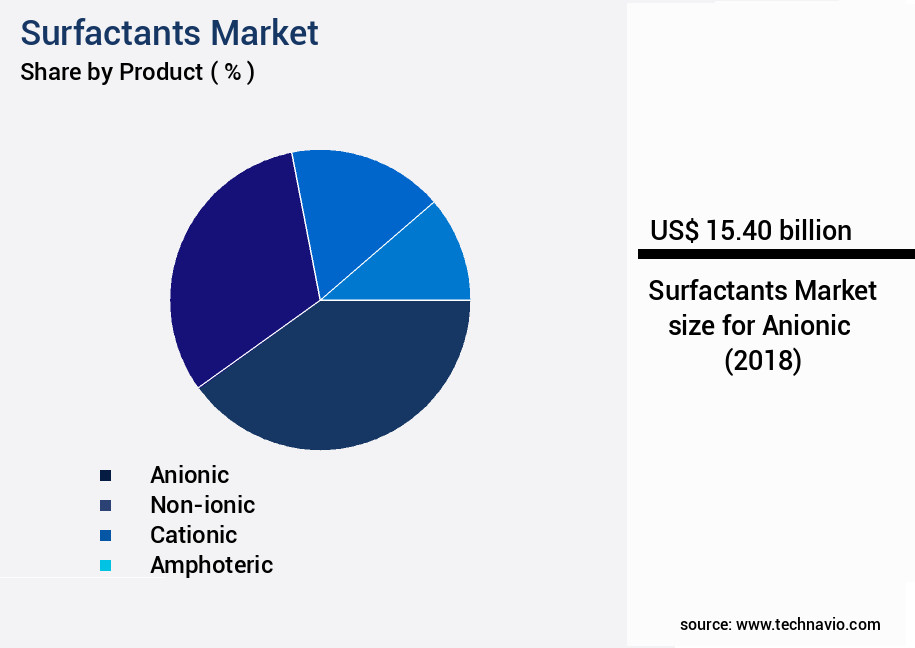
The Anionic segment was valued at USD 15.40 billion in 2018 and showed a gradual increase during the forecast period.
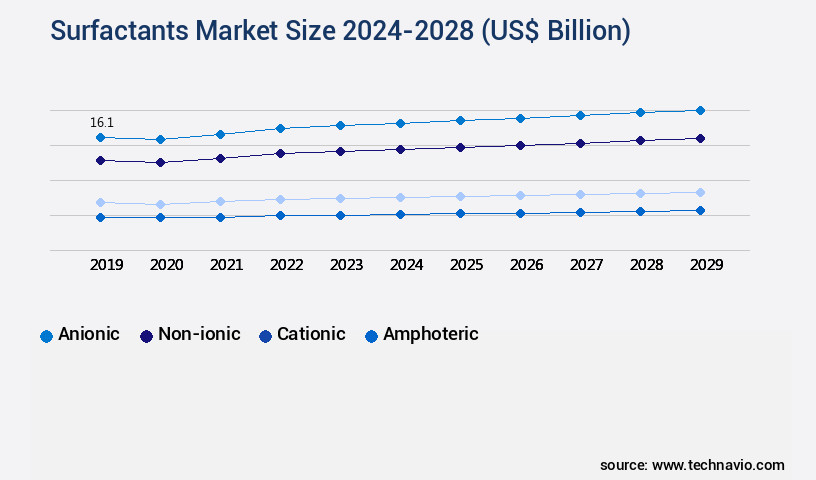
Request Free Sample
Regional Analysis
APAC is estimated to contribute 43% to the growth of the global market during the forecast period.Technavio’s analysts have elaborately explained the regional trends and drivers that shape the market during the forecast period.
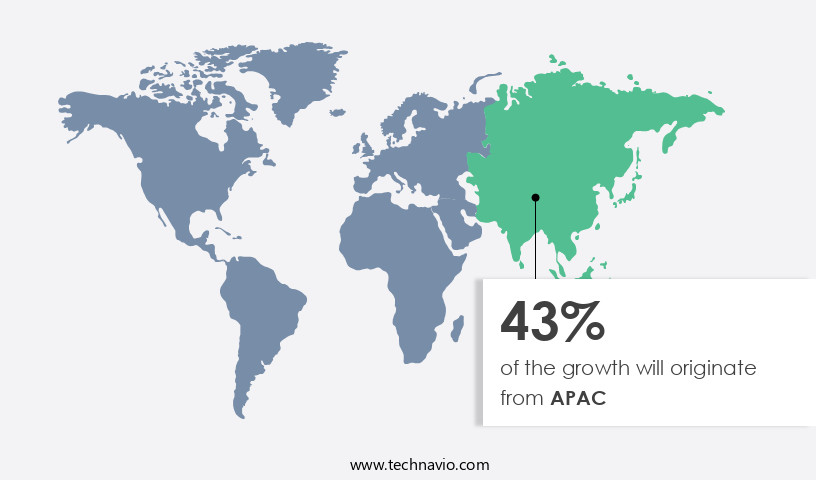
See How Surfactants Market Demand is Rising in APAC Request Free Sample
The market in Asia Pacific (APAC) is experiencing significant growth, with several countries, including China, India, Indonesia, Thailand, Australia, Japan, the Philippines, Malaysia, and South Korea, driving the demand for surfactants. China, as a major consumer of detergents, and its anticipated position as the largest cosmetic market globally during the forecast period, significantly contributes to the market's expansion. Population growth and increasing disposable income in APAC are key factors fueling the demand for surfactants. Furthermore, the emergence of China and India as manufacturing hubs in the region is expected to boost industrial and institutional cleaning and food processing applications.
According to recent industry reports, APAC is projected to witness a growth rate of approximately 6% in surfactant consumption in the detergent industry. Additionally, the personal care sector is anticipated to grow by around 7%, with a similar growth rate expected in the food processing industry. The market's expansion is also influenced by the increasing adoption of surfactants in various applications, such as oilfield chemicals, pharmaceuticals, and agrochemicals. The market is expected to reach a value of around USD70 billion by 2026, growing at a rate of around 5% per year. In comparison to the current market size, the future growth prospects of the market are promising.
The market's expansion is attributed to the growing demand for surfactants in various industries, including detergents, personal care, food processing, and others. The increasing focus on research and development in the production of eco-friendly surfactants is also expected to contribute to market growth. In conclusion, the market in APAC is experiencing substantial growth, driven by the increasing demand from various industries and the growing population and disposable income in the region. The market is expected to reach significant value by 2026, growing at a steady rate during the forecast period.
Market Dynamics
Our researchers analyzed the data with 2023 as the base year, along with the key drivers, trends, and challenges. A holistic analysis of drivers will help companies refine their marketing strategies to gain a competitive advantage.
Advancements and Performance Improvements in the US Surfactant Market: Focus on Degradation Pathways, Compliance, and Innovation
The US surfactant market continues to evolve, driven by advancements in technology and increasing demand for eco-friendly and high-performing products. One significant area of focus is understanding alkyl benzene sulfonate degradation pathways to minimize environmental impact.
Surfactant concentration plays a crucial role in foam height, with nonionic surfactants demonstrating superior performance. To ensure optimal results, determining the cloud point of nonionic surfactants is essential. Anionic surfactant critical micelle concentrations (CMC) are also vital for formulation development and process efficiency.
Innovation in the surfactant industry includes the development of antimicrobial cationic surfactants, which undergo rigorous testing to meet OECD biodegradability standards. Understanding surfactant interaction with soil particles is another critical factor, as it influences wetting and emulsification properties.
Surfactants play a vital role in the detergent process, improving efficiency and reducing downtime. In the oil industry, surfactants are used in enhanced oil recovery processes to increase production.
Formulation selection criteria for surfactants include performance, sustainability, and environmental impact. Comparing various surfactant types, such as anionic, cationic, and nonionic, can provide valuable insights into their respective strengths and weaknesses.
Sustainable surfactant development strategies are gaining traction, with a focus on reducing toxicity to aquatic organisms and minimizing environmental impact. Synergistic effects of surfactant mixtures and micellar solubilization of hydrophobic compounds further expand their applications.
In conclusion, the US surfactant market is characterized by continuous innovation, improved performance, and a growing focus on sustainability and compliance. By understanding these trends and advancements, businesses can make informed decisions and stay competitive in this dynamic industry.
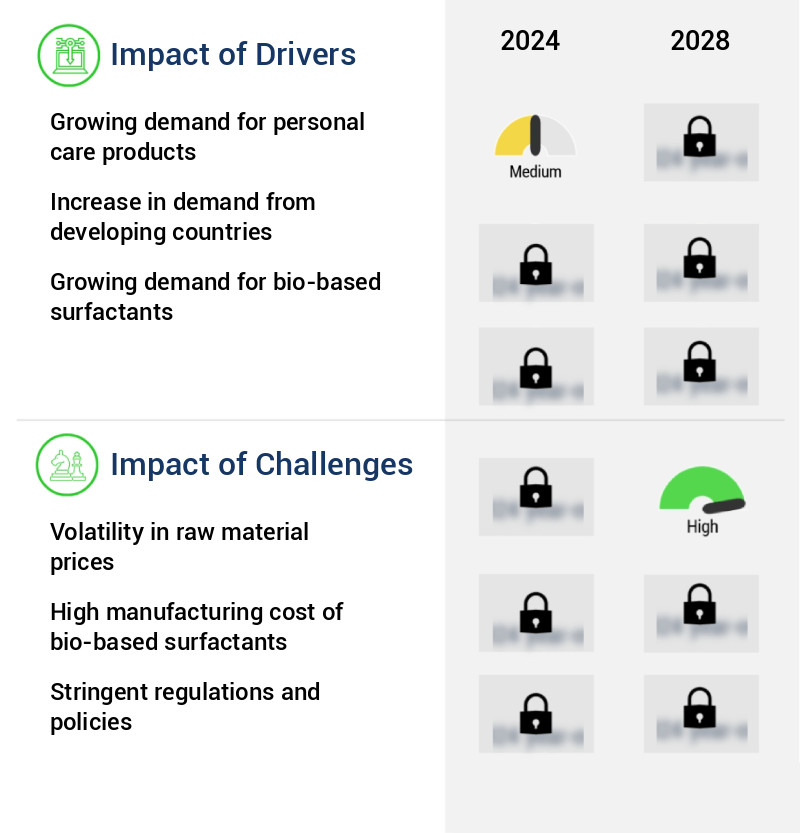
What are the key market drivers leading to the rise in the adoption of Surfactants Industry?
- The surge in consumer preference for personal care items serves as the primary catalyst for market expansion.
- The market encompasses a wide range of chemicals used to reduce the surface tension between two liquids, a solid and a liquid, or a gas and a liquid. These substances are integral to various industries, including personal care, agriculture, food and beverage, and oil and gas. In the personal care sector, surfactants play a crucial role in the production of cleansing agents, such as shampoos, shower gels, and hair conditioners. They generate foam and cleanse the skin gently, making them indispensable in personal care applications. Surfactants also function as emulsifiers in lotions and creams, stabilizing oil droplets and water.
- This property is essential in sunscreen and skincare cosmetics, allowing for quick absorption and leaving a non-greasy finish. The demand for surfactants in personal care applications continues to expand due to the increasing popularity of cosmetics and personal care products. This trend is driven by factors such as changing consumer preferences and the growing awareness of personal hygiene. Moreover, surfactants are essential in the food and beverage industry, where they act as emulsifiers, stabilizers, and foaming agents. In agriculture, they are used as wetting agents, reducing the surface tension between water and soil, enhancing the efficiency of pesticides and fertilizers.
- In the oil and gas sector, surfactants are used in drilling operations, improving the flow of oil and gas from reservoirs. The versatility of surfactants and their applications across various industries make them a vital component in numerous processes. The market for surfactants is continuously evolving, with ongoing research and development efforts aimed at creating more effective and sustainable surfactant solutions. This dynamic market landscape presents both opportunities and challenges for manufacturers and consumers alike.
What are the market trends shaping the Surfactants Industry?
- Increase in research and development (R&D) activities is a mandated market trend. This trend signifies a significant focus on innovation and improvement within industries.
- The market is characterized by continuous evolution and growth, driven by increasing research and development (R&D) investments from major players. Manufacturers are focusing on reducing manufacturing costs and delivering products with enhanced properties to maintain their competitive edge. Clariant, for instance, offers mild surfactants for personal care applications, such as GlucoTain Plus and Gluionic Liquid, which are sulfate-free, biodegradable, preservative-free, and free from ethoxylated ingredients. These mild surfactants cater to the growing demand for eco-friendly and gentle personal care products. Another significant trend in the market is the emphasis on new product development and innovations.
- For instance, Solvay's Pluracare range of nonionic surfactants is designed for various applications, including personal care, household cleaning, and industrial applications. These surfactants offer improved performance, biodegradability, and sustainability, making them a popular choice among consumers and businesses. The increasing adoption of these advanced surfactants in various industries, including personal care, agriculture, and food and beverage, is expected to fuel the growth of the market. Additionally, the rising awareness of environmental sustainability and the growing demand for eco-friendly products are further boosting the market's expansion. Despite the challenges posed by raw material price volatility and regulatory compliance, the market is poised for steady growth, offering significant opportunities for both established players and new entrants.
What challenges does the Surfactants Industry face during its growth?
- The volatility in raw material prices poses a significant challenge to the industry's growth trajectory. In order to maintain competitiveness and profitability, businesses must closely monitor and adapt to fluctuations in the cost of essential inputs.
- Surfactants are essential industrial chemicals used to reduce surface tension between two liquids or between a liquid and a solid. The primary raw materials for producing surfactants include linear alkylbenzene (LAB), detergent alcohols, and ethylene oxide (EO). The cost of these raw materials can be volatile due to their derivation from downstream petroleum products. In China, the average cost of domestic EO ranges between USD45 per tonne and USD1,314 per tonne, excluding warehouse fees. The price fluctuations are primarily driven by the limited supply of ethylene C2 type, a key feedstock for EO production. Furthermore, Sanjiang Fine Chemicals, a significant EO producer in China, has temporarily shuttered two plants, each with a capacity of 60,000 tonnes per year, in Zhejiang province due to insufficient ethylene availability.
- The market is a dynamic and evolving sector, with ongoing developments and trends shaping its landscape. Applications for surfactants span various industries, including agriculture, food and beverage, textiles, and personal care. The market's continuous growth can be attributed to the increasing demand for these versatile chemicals in various applications, as well as advancements in production technologies and raw material sourcing strategies. Despite the challenges in raw material availability and price volatility, the market remains a significant contributor to the global chemical industry. Companies and researchers are actively exploring alternative raw materials and production methods to mitigate the impact of price fluctuations and ensure a stable supply of surfactants for various applications.
Exclusive Customer Landscape
The surfactants market forecasting report includes the adoption lifecycle of the market, covering from the innovator’s stage to the laggard’s stage. It focuses on adoption rates in different regions based on penetration. Furthermore, the surfactants market report also includes key purchase criteria and drivers of price sensitivity to help companies evaluate and develop their market growth analysis strategies.
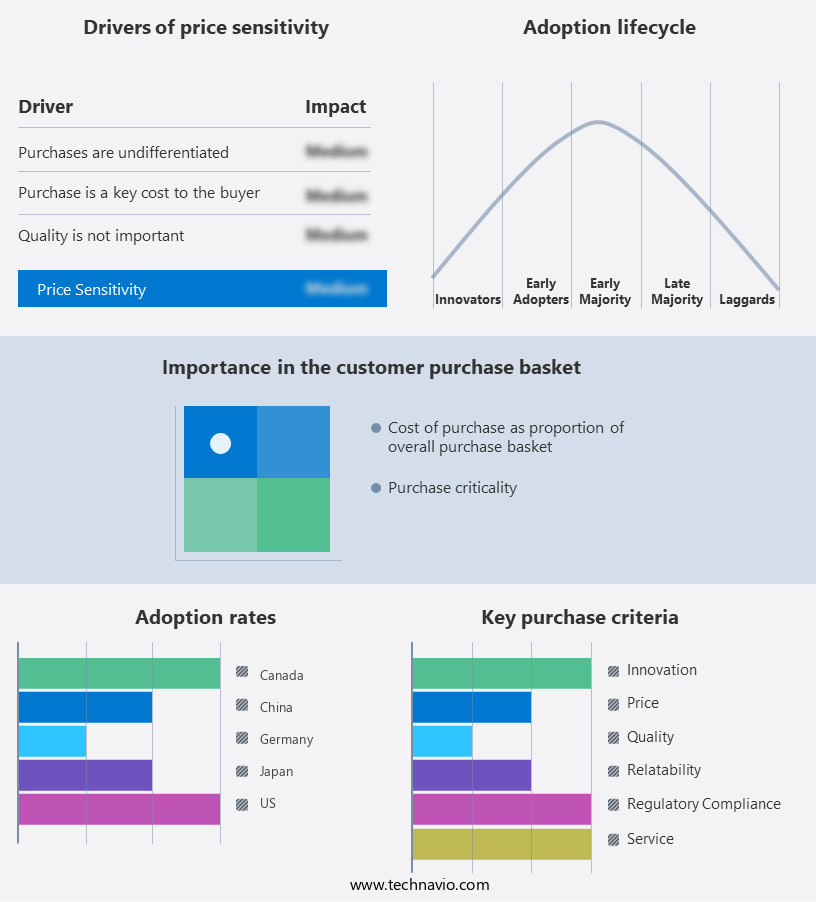
Customer Landscape of Surfactants Industry
Key Companies & Market Insights
Companies are implementing various strategies, such as strategic alliances, surfactants market forecast, partnerships, mergers and acquisitions, geographical expansion, and product/service launches, to enhance their presence in the industry.
3B Scientific - This company specializes in the development and distribution of innovative sports products, leveraging advanced technology and research to enhance athlete performance and consumer experience. Their offerings span various categories, including equipment, apparel, and nutrition. By focusing on product quality and consumer needs, they distinguish themselves in the competitive market.
The industry research and growth report includes detailed analyses of the competitive landscape of the market and information about key companies, including:
- 3B Scientific
- AkzoNobel
- Arkema S.A.
- Ashland Global Holdings
- BASF SE
- Clariant AG
- Croda International
- Dow Inc.
- Evonik Industries
- Galaxy Surfactants
- Huntsman Corporation
- Kao Corporation
- KLK Oleo
- Lion Corporation
- Nouryon
- Pilot Chemical
- Sasol
- Stepan Company
- Sumitomo Chemical
- Unilever
Qualitative and quantitative analysis of companies has been conducted to help clients understand the wider business environment as well as the strengths and weaknesses of key industry players. Data is qualitatively analyzed to categorize companies as pure play, category-focused, industry-focused, and diversified; it is quantitatively analyzed to categorize companies as dominant, leading, strong, tentative, and weak.
Recent Development and News in Surfactants Market
- In January 2024, BASF SE, a leading global supplier of chemicals, announced the expansion of its production capacity for alkyl polyglycosides (APG), a type of surfactant, at its Ludwigshafen site in Germany. This expansion aimed to meet the growing demand for sustainable surfactants in various industries (BASF press release, 2024).
- In March 2024, Dow Inc. And DuPont de Nemours entered into a strategic collaboration to develop innovative surfactant solutions for the agro sciences market. This collaboration combined Dow's surfactant expertise with DuPont's agro sciences capabilities, aiming to create more effective and sustainable agrochemical formulations (Dow Inc. Press release, 2024).
- In May 2024, Clariant International AG, a Swiss specialty chemical company, completed the acquisition of the specialty additives business of Huntsman Corporation. This acquisition included Huntsman's surfactants and intermediates business, significantly expanding Clariant's product portfolio and market presence in the market (Clariant press release, 2024).
- In February 2025, Lonza Group AG, a Swiss life sciences company, received regulatory approval from the European Commission for its new production site for nonionic surfactants in Antwerp, Belgium. This state-of-the-art facility is expected to increase Lonza's production capacity and improve its ability to serve customers in the European market (Lonza press release, 2025).
Research Analyst Overview
- The market for surfactants continues to evolve, driven by advancements in technology and the expanding application scope across various industries. Silicone surfactants and fatty acid esters are among the key types of surfactants witnessing significant demand due to their unique properties. Silicone surfactants, with their low surface tension and excellent rheological properties, find extensive use in industrial processes, particularly in the production of coatings, adhesives, and personal care products. Their ability to enhance solubilization and reduce surface tension makes them indispensable in various applications. On the other hand, fatty acid esters, derived from renewable resources, are gaining popularity due to their biodegradability and low toxicity.
- They are extensively used in cleaning formulations, cosmetics, and as emulsifiers in food and pharmaceutical industries. The market for surfactants is expected to grow at a steady pace, with an estimated growth rate of 5% per annum. This growth is attributed to the increasing demand for surfactants in various industries, including agriculture, where they are used as wetting agents and dispersants in agricultural chemicals. Cationic surfactants, with their unique ability to provide stability to dispersions and enhance detergency mechanism, are another crucial segment of the surfactant market. Their application in cleaning formulations, particularly in hard surface cleaners, is on the rise due to their superior performance.
- The development of application-specific surfactants, such as amphoteric surfactants and polymer surfactants, is a significant trend in the market. These surfactants offer enhanced properties, such as improved foaming properties, critical micelle concentration, and hydrophilic-lipophilic balance, making them suitable for specific applications. Despite the numerous benefits, the use of surfactants is not without challenges. Toxicity evaluation and environmental impact assessment are critical considerations in the surfactant market. The development of eco-friendly surfactants, such as those derived from renewable resources, is a key focus area for researchers and manufacturers. Surfactant mixtures, including alkyl ethoxylates, alkyl sulfates, and fluorinated surfactants, are also gaining popularity due to their ability to provide enhanced performance in various applications.
- The ongoing research and development in surfactant synthesis, biodegradability assessment, and toxicity evaluation are expected to drive the market's continued growth and evolution.
Dive into Technavio’s robust research methodology, blending expert interviews, extensive data synthesis, and validated models for unparalleled Surfactants Market insights. See full methodology.
|
Market Scope
|
|
Report Coverage
|
Details
|
|
Page number
|
203
|
|
Base year
|
2023
|
|
Historic period
|
2018-2022 |
|
Forecast period
|
2024-2028
|
|
Growth momentum & CAGR
|
Accelerate at a CAGR of 5.23%
|
|
Market growth 2024-2028
|
USD 13.2 billion
|
|
Market structure
|
Fragmented
|
|
YoY growth 2023-2024(%)
|
4.84
|
|
Key countries
|
US, Canada, Germany, UK, Italy, France, China, India, Japan, Brazil, Egypt, UAE, Oman, Argentina, KSA, UAE, Brazil, and Rest of World (ROW)
|
|
Competitive landscape
|
Leading Companies, Market Positioning of Companies, Competitive Strategies, and Industry Risks
|
Request Free Sample
What are the Key Data Covered in this Surfactants Market Research and Growth Report?
- CAGR of the Surfactants industry during the forecast period
- Detailed information on factors that will drive the growth and forecasting between 2024 and 2028
- Precise estimation of the size of the market and its contribution of the industry in focus to the parent market
- Accurate predictions about upcoming growth and trends and changes in consumer behaviour
- Growth of the market across APAC, North America, Europe, South America, and Middle East and Africa
- Thorough analysis of the market’s competitive landscape and detailed information about companies
- Comprehensive analysis of factors that will challenge the surfactants market growth of industry companies
We can help! Our analysts can customize this surfactants market research report to meet your requirements.
Get in touch







![]() Get the report (PDF) sent to your email within minutes.
Get the report (PDF) sent to your email within minutes.
Complimentary full Excel data with your report purchase.